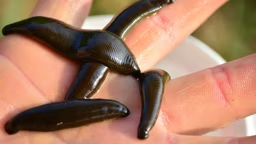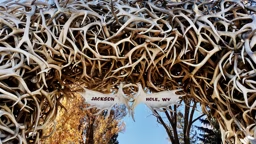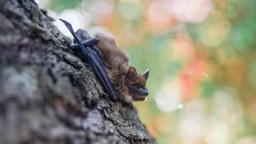Turtles & Frogs
Among aquatic, cold-blooded vertebrate animals, turtles and frogs may at first appear to share similar strategies. Turtles often bury themselves in mud below the water’s surface, deep enough to escape freezing. Frogs may be partially buried in mud, but usually keep much of their bodies just above the surface of the silt.
While turtles shut down so deeply that they are able to survive extreme oxygen deprivation of the surrounding mud and water, frogs require well-oxygenated water to survive hibernation. Turtles cease breathing, and many will not survive the winter’s task. Frogs, more capable of taking in oxygen through the skin, are able to remain somewhat active, despite the lack of breathing, and sometimes may be seen swimming under the ice.
Snakes
For some species of snakes, the den is much more than a place to survive the winter. Often, these dens are highly social places where dozens or even hundreds of snakes congregate. As warming spring air reawakens the cold-blooded snakes’ zest for life, breeding begins. Garter snakes, for example, are famous for emerging with spring fever, males pursuing females while still in the stupor of a long winter’s slumber.
Among aquatic, cold-blooded vertebrate animals, turtles and frogs may at first appear to share similar strategies. Turtles often bury themselves in mud below the water’s surface, deep enough to escape freezing. Frogs may be partially buried in mud, but usually keep much of their bodies just above the surface of the silt.
While turtles shut down so deeply that they are able to survive extreme oxygen deprivation of the surrounding mud and water, frogs require well-oxygenated water to survive hibernation. Turtles cease breathing, and many will not survive the winter’s task. Frogs, more capable of taking in oxygen through the skin, are able to remain somewhat active, despite the lack of breathing, and sometimes may be seen swimming under the ice.
Snakes
For some species of snakes, the den is much more than a place to survive the winter. Often, these dens are highly social places where dozens or even hundreds of snakes congregate. As warming spring air reawakens the cold-blooded snakes’ zest for life, breeding begins. Garter snakes, for example, are famous for emerging with spring fever, males pursuing females while still in the stupor of a long winter’s slumber.
Black Bears
Black bears don’t go into an extreme metabolic shutdown the way turtles or bats do, but they do undergo significant metabolic changes that put them squarely into the category of true hibernator.
Black bears shift blood flow considerably from the extremities, lower their breathing and heart rates to a fraction of the norm, and lower their resting body temperatures a little. When the body temperature begins to dip too low, the bear will rouse and move around a bit – a small metabolic trick that releases enough energy to raise the body temperature back to its critical low.
Black bears don’t go into an extreme metabolic shutdown the way turtles or bats do, but they do undergo significant metabolic changes that put them squarely into the category of true hibernator.
Black bears shift blood flow considerably from the extremities, lower their breathing and heart rates to a fraction of the norm, and lower their resting body temperatures a little. When the body temperature begins to dip too low, the bear will rouse and move around a bit – a small metabolic trick that releases enough energy to raise the body temperature back to its critical low.
Ground Squirrels & Pikas
In the northern Rocky Mountains, the golden-mantled ground squirrel shares the high rock-scattered slopes with the rabbit-like pika. Both animals are herbivores and rely on short grasses and alpine meadow herbs. Both dart in and out of the spaces between rock piles.
The pika does not hibernate, surviving winter on gathered haystack-like piles of forage, but the golden-mantled squirrel is a profound hibernator, slowing its heartbeat to just five beats per minute and maintaining a body temperature a single degree above the ambient temperature of its winter den.
In the northern Rocky Mountains, the golden-mantled ground squirrel shares the high rock-scattered slopes with the rabbit-like pika. Both animals are herbivores and rely on short grasses and alpine meadow herbs. Both dart in and out of the spaces between rock piles.
The pika does not hibernate, surviving winter on gathered haystack-like piles of forage, but the golden-mantled squirrel is a profound hibernator, slowing its heartbeat to just five beats per minute and maintaining a body temperature a single degree above the ambient temperature of its winter den.
As winter arrives, I find I am a changed man with the first snowfall. In the ensuing weeks, my appetite for rich foods grows, as does my love of extended slumbers, watching football on the couch, and all things slothful. Perhaps, in a way so akin to my animal neighbors, I am shutting … down … for winter.
The way each beloved wild mammal, bird, reptile, amphibian, fish, and invertebrate responds to winter is of great interest to us. Perhaps it’s because we feel for the beauty that is cast into a bleak vestige of its former summer self. Maybe it’s the warmth of our homes that makes us sympathize with those wild personalities exposed to the harsh elements. Or, just maybe, we experience many of the same instinctive cues from our environment that slow us down and remind us that it wasn’t long ago that we, too, needed to survive such exposure.
A Metabolic Bag of Tricks
Imagine if you knew you would not wake for six months, that nearly 70 percent of the water in your body was going to freeze solid, and that “survival” would be defined for you as “the majority of your cells will not freeze and rupture!” You would awake in need of healing, but you would survive. Perhaps it’s a good thing that the brain of North America’s wood frog is smaller than a smashed pea. I don’t think a wood frog wants to know what it’s going through each year.
In northern latitudes of North America, a number of species survive by circulating sugars into the blood and distributing various versions of sugars and alcohols to every cell in the body. They do this as the body is slowly freezing. Cold-blooded species that hide under bark, under leaves, and in shallow crevices are the best candidates for this survival game of biochemistry.
When the cells of these animals are infused with their special-order, carbon-rich molecules, ice crystals are unable to form, allowing cells to survive bitter cold without experiencing a fatal membrane rupture. When the majority of the cells survive the winter, the animal is able to thaw out and begin its life again. These miraculous creatures include the mourning cloak butterfly and frogs, such as the wood frog, spring peeper, chorus frog, and tree frog, to name a few.
The way each beloved wild mammal, bird, reptile, amphibian, fish, and invertebrate responds to winter is of great interest to us. Perhaps it’s because we feel for the beauty that is cast into a bleak vestige of its former summer self. Maybe it’s the warmth of our homes that makes us sympathize with those wild personalities exposed to the harsh elements. Or, just maybe, we experience many of the same instinctive cues from our environment that slow us down and remind us that it wasn’t long ago that we, too, needed to survive such exposure.
A Metabolic Bag of Tricks
Imagine if you knew you would not wake for six months, that nearly 70 percent of the water in your body was going to freeze solid, and that “survival” would be defined for you as “the majority of your cells will not freeze and rupture!” You would awake in need of healing, but you would survive. Perhaps it’s a good thing that the brain of North America’s wood frog is smaller than a smashed pea. I don’t think a wood frog wants to know what it’s going through each year.
In northern latitudes of North America, a number of species survive by circulating sugars into the blood and distributing various versions of sugars and alcohols to every cell in the body. They do this as the body is slowly freezing. Cold-blooded species that hide under bark, under leaves, and in shallow crevices are the best candidates for this survival game of biochemistry.
When the cells of these animals are infused with their special-order, carbon-rich molecules, ice crystals are unable to form, allowing cells to survive bitter cold without experiencing a fatal membrane rupture. When the majority of the cells survive the winter, the animal is able to thaw out and begin its life again. These miraculous creatures include the mourning cloak butterfly and frogs, such as the wood frog, spring peeper, chorus frog, and tree frog, to name a few.
Woodchucks
Groundhog Day is, thankfully, a tradition with no real biological consequence. The woodchuck, it turns out, is not a reliable predictor of winter length. Woodchucks and marmots are true hibernators, large rodents with ample supplies of thick, brown fat. They slow their heart rates to less than five beats per minute and find ways to seal up their winter dens. What the animal does when it comes to the surface of the den in late winter is dependent upon the day at hand and has little to do with the remaining winter.
Birds
While no bird truly enters into a long-term commitment with hibernation, some species conserve valuable energy by shutting down for a couple of hours each day. This short-term extreme is known as “torpor.”
The common poorwill makes its mark in the bird world with an unmatched body-temperature plunge, an astonishing dip of nearly half of its wakeful temperature, from a feverish 106 degrees Fahrenheit to the hypothermic mid-60s.
While other birds only enter torpid states for an hour or two, the poorwill may remain in torpor for days, weeks, and, in rare cases, months when food supplies are lacking. Scientists have found that a torpid poorwill slows its metabolic rate by more than 90 percent and can live 100 days on just 10 grams of fat.
Wakefulness
In the conservation classic, A Sand County Almanac, Aldo Leopold wrote of following skunk tracks in the snow during a January thaw. His tale brings to light the fact that some hibernating animals become active on warm winter days and that people may be privileged to learn about so many of their wild neighbors through tracks in the snow.
In my own mid-winter walks, usually on brisk, frozen days, I see another side. In the absence of evidence, I no longer look at snow banks, stumps, rock piles, and dead-fallen logs in the same way. I imagine the animals that must be there. Often, they are just inches from my boots and gloves, stowed away within the cavernous spaces, the burrows, and knotholes.
In their various states of suspended animation, our animal friends abound all around us, silent to the world, hidden from view, nestled in habitat structure that is perhaps more critical in its life-preserving role than any other time of year.
Breathing in that fresh winter air, I feel thankful to be among the wakeful, returning from a sparkling snowscape to a feast of yams and wild rice, grateful for a warm fire and soft bed at the end of a good winter’s day. I will rejoice in a good night’s sleep, knowing that there are those less fortunate, animals that are much less active but sleep-deprived nonetheless, animals that will hopefully endure another winter in hibernation.
Brian M. Collins feels the effects of winter as it turns a crisp metabolism and vigorous mental alertness into mid-winter mush. No doubt, the biochemistry of hibernation is part of the human equation too.
While no bird truly enters into a long-term commitment with hibernation, some species conserve valuable energy by shutting down for a couple of hours each day. This short-term extreme is known as “torpor.”
The common poorwill makes its mark in the bird world with an unmatched body-temperature plunge, an astonishing dip of nearly half of its wakeful temperature, from a feverish 106 degrees Fahrenheit to the hypothermic mid-60s.
While other birds only enter torpid states for an hour or two, the poorwill may remain in torpor for days, weeks, and, in rare cases, months when food supplies are lacking. Scientists have found that a torpid poorwill slows its metabolic rate by more than 90 percent and can live 100 days on just 10 grams of fat.
Wakefulness
In the conservation classic, A Sand County Almanac, Aldo Leopold wrote of following skunk tracks in the snow during a January thaw. His tale brings to light the fact that some hibernating animals become active on warm winter days and that people may be privileged to learn about so many of their wild neighbors through tracks in the snow.
In my own mid-winter walks, usually on brisk, frozen days, I see another side. In the absence of evidence, I no longer look at snow banks, stumps, rock piles, and dead-fallen logs in the same way. I imagine the animals that must be there. Often, they are just inches from my boots and gloves, stowed away within the cavernous spaces, the burrows, and knotholes.
In their various states of suspended animation, our animal friends abound all around us, silent to the world, hidden from view, nestled in habitat structure that is perhaps more critical in its life-preserving role than any other time of year.
Breathing in that fresh winter air, I feel thankful to be among the wakeful, returning from a sparkling snowscape to a feast of yams and wild rice, grateful for a warm fire and soft bed at the end of a good winter’s day. I will rejoice in a good night’s sleep, knowing that there are those less fortunate, animals that are much less active but sleep-deprived nonetheless, animals that will hopefully endure another winter in hibernation.
Brian M. Collins feels the effects of winter as it turns a crisp metabolism and vigorous mental alertness into mid-winter mush. No doubt, the biochemistry of hibernation is part of the human equation too.
WHAT IS HIBERNATION?
Hibernation, it turns out, is not so straightforward or easily defined. The species that endure some kind of metabolic shutdown employ several strategies. To be clear, hibernation is not sleep. It is a process that preserves life through minimal effort, a process that causes the body to veer widely from the usual metabolic hum. Some species dive into the depths of low body temperatures, greatly slowed heart rates, and halted breathing for months. Others wake almost daily to kick-start their metabolism and get comfy and snuggled anew. And there are examples that fill in the blanks at all levels in between.
WHO HIBERNATES?
• Bats hibernate, deeply, in caves that have just the right above-freezing temperature to accommodate a successful over-winter lethargy.
• Frogs, salamanders, snakes and turtles use a variety of extreme metabolic makeovers, often surviving winter underwater and with vitals barely ticking.
• Woodchucks (groundhogs), marmots, ground squirrels, and a few other rodents keep their bodies just a few degrees warmer than the air inside their hibernacula, while some of their kin remain active all winter.
• Skunks, raccoons, and bears venture out to find food and get a little exercise on warm winter days, even if they’re experiencing a myriad of metabolic mysteries associated with hibernation.
• Many varieties of insects go dormant under bark and leaf litter – sometimes in eggs, sometimes as adults. To the extreme, some species even freeze solid, thawing “back to life” in the warming days of spring.
• A little less extreme, the black-capped chickadees visiting the bird feeder in mid-winter are surviving with the rich, oily fats of your sunflower seeds, a variety of wild foods (including those hibernating bugs), and a little midnight mini-hibernation called “torpor.”
Hibernation, it turns out, is not so straightforward or easily defined. The species that endure some kind of metabolic shutdown employ several strategies. To be clear, hibernation is not sleep. It is a process that preserves life through minimal effort, a process that causes the body to veer widely from the usual metabolic hum. Some species dive into the depths of low body temperatures, greatly slowed heart rates, and halted breathing for months. Others wake almost daily to kick-start their metabolism and get comfy and snuggled anew. And there are examples that fill in the blanks at all levels in between.
WHO HIBERNATES?
• Bats hibernate, deeply, in caves that have just the right above-freezing temperature to accommodate a successful over-winter lethargy.
• Frogs, salamanders, snakes and turtles use a variety of extreme metabolic makeovers, often surviving winter underwater and with vitals barely ticking.
• Woodchucks (groundhogs), marmots, ground squirrels, and a few other rodents keep their bodies just a few degrees warmer than the air inside their hibernacula, while some of their kin remain active all winter.
• Skunks, raccoons, and bears venture out to find food and get a little exercise on warm winter days, even if they’re experiencing a myriad of metabolic mysteries associated with hibernation.
• Many varieties of insects go dormant under bark and leaf litter – sometimes in eggs, sometimes as adults. To the extreme, some species even freeze solid, thawing “back to life” in the warming days of spring.
• A little less extreme, the black-capped chickadees visiting the bird feeder in mid-winter are surviving with the rich, oily fats of your sunflower seeds, a variety of wild foods (including those hibernating bugs), and a little midnight mini-hibernation called “torpor.”
 Brian M. Collins
Brian M. Collins 















